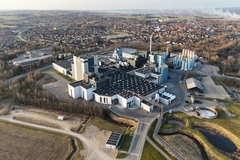
- Industry news
Industry news
- Category news
Category news
- Reports
- Key trends
- Multimedia
- Journal
- Events
- Suppliers
- Home
- Industry news
Industry news
- Category news
Category news
- Reports
- Key trends
- Multimedia
- Events
- Suppliers
KEY INTERVIEW: Tetra Pak’s Tradition Inspires Processing Innovation

30 Sep 2016 --- Swedish-headquartered Tetra Pak may be best known for its aseptic packaging technology for dairy and beverage products, but the company’s processing systems for prepared food also have vast global scale. Ongoing market trends towards convenience and clean label, but also greater manufacturer demands around cost optimization and sustainability, are inspiring the company to create breakthrough technologies such as the Tetra Pak Coiled Heat Exchanger.
“We like to think of our solutions as intelligent customization,” Anders Yngwe-Söderstjerna, (pictured) Tetra Pak’s Manager Centre of Expertise Prepared Food tells FoodIngredientsFirst in a detailed interview. “We are looking at how we can utilize our portfolio on a modular basis and bring it together on a project basis, which is customized to the needs of the customer.  We are putting quite a lot of effort behind that, so that we can conduct a complex project in a controlled and efficient way, while also ascribing the required customization.”
We are putting quite a lot of effort behind that, so that we can conduct a complex project in a controlled and efficient way, while also ascribing the required customization.”

Anders Yngwe-Söderstjerna has been at Tetra Pak for about 5 years, after various roles within the FMCG space, including a long spell at Unilever. “The group I lead is responsible for the solutions in the product portfolio. I also have a team of food technologists, as well as being responsible for business development and strategic planning,” he explains.
The manager notes several dominant market trends, some of which have been ongoing for quite a long time. “There is a craving for homemade taste. In recent years, there have been an increasing number of nutritional trends too, where consumers and customers are seeking solutions that go in a healthier direction. We are also seeing demand for less additives and preservatives in food. Last but not least is the convenience trend. This has been going on in Europe, North America and Japan for some time, but that is coming more in developing markets too.”
Advances in processing are leading to greater gains, which allow for the creation of products with a “cleaner” label. “Achieving this could include anything from how we are mixing the products or picking them up in the mixing phase. To do so in a natural way requires processing with control of the equipment and parameters. But it could also be in terms of how we utilize heat treatment. The more sensitive and controlled we are, the less additives that are required to protect the food and therefore the more natural we can make it,” says Anders Yngwe-Söderstjerna.
The biggest shift within food systems relates to the creation of more controlled and sensitive processing. Some of the more traditional technologies that originated in the 1960s and 1970s can be placed side by side into a more modern system. “For example, there is a shift from batch production into more continuous batch production, to have movements going from retort into continuous production too,” he notes.
The company’s most significant recent innovation takes some of the company’s knowledge of dairy and beverage technology processing into food. Tetra Pak’s coiled heat exchanger provides efficient heating and cooling of low to high viscous and smooth to particulate food products. The pressure rating of the system enables the process higher capacities of high viscous products, improving production efficiency and cutting cost per liter. The coiled mono-tube unit – between 30 and 100 meters long – has only one inlet and one outlet connection. This enables gentle mechanical treatment and ensures excellent particle integrity for particles of up to 25mm in diameter.
“In the past, we have had a problem in going up in high viscosities, as well as in treating bigger particulates in our continuous systems,” says Anders Yngwe-Söderstjerna. “This coiled heat exchanger allows us to get these viscosities and  take particles of up to 25mm in size, while still having good integrity of the particles. This is taking processing that before we were able to do in pure liquids into prepared foods, such as soups, sauces and fruit preparations,” he explains, “It allows us to have a more precise heat treatment for the liquid phase as well as for the particles and avoids the need for a compromise.”
take particles of up to 25mm in size, while still having good integrity of the particles. This is taking processing that before we were able to do in pure liquids into prepared foods, such as soups, sauces and fruit preparations,” he explains, “It allows us to have a more precise heat treatment for the liquid phase as well as for the particles and avoids the need for a compromise.”
He stresses that the benefits go beyond delivering the equipment alone, it is also about having the knowledge of how to go about the process. “So together with that launch, we have also gone some way in terms of the understanding the heat treatment systems. Together with this, we also now have the calculations, which allow us to predict the heat treatment for these applications. That allows us to do a more precise heat treatment that also functions from both a cost and environmental perspective,” he claims.
What then about other advances in the food technology, such as pulsed electric fields and high pressure processing? Are there any ways in which these technologies can overlap with existing ones in the Tetra Pak portfolio? “Coiled tubular heat exchange is an equally emerging technology because it hasn’t really been available for thicker viscosities and particulates,” he stresses.
But he is open to ideas, with the company assessing correlations between emerging technologies. “In the past, it may have been more of a black and white choice in terms of systems, but now there are more opportunities for synergies between them in terms of delivering productivity, quality, capacity, handling and also the cost implications,” he notes.
Located in the US, Sweden, Singapore, China, Japan, India and Brazil, Tetra Pak Product Development Centres (PDC's) serve as a customer resource for developing into new products and categories. The company also have specialized centers for ice cream in Denmark, evaporation and drying in the Netherlands and powders in France. “Our PDC’s allow customers to go in and test the equipment and work together with our food technologists, in helping them to understand the process parameters and design the optimal equipment setup and then define how that should be run,” notes Anders Yngwe-Söderstjerna. The company has especially invested significantly at its Lund (Sweden) headquarters recently. “As an example we have quite recently built in the new coiled heat exchanger so that customers can come here and work on their applications on that system,” he adds.
So what else is in the development pipeline? “We have quite a broad program in general, but we are doing things both in terms of the equipment, but also in terms of how we should actually run it. We see that there are opportunities to optimize how things are running. That’s what you also do in order to make gains in performance with less preservatives and additives, but also in terms of cost and sustainability.
Anders Yngwe-Söderstjerna notes the launch of the Schwartau Fruttissima fruit spread product in Germany several years ago, as an example of how Tetra Pak can partner with a customer on innovation. “We were looking at re-modeling their portfolio together with them. We came up with a process solution that allows for a fresher product with a fresher taste, with a better appearance and palatability, as well as delivering a significant portion of fruit pieces into the model. This is about keeping the particle integrity of the pieces better. That was about really taking the preserves category a few steps further and delivering a more premium proposition. It was about having both the knowledge and the equipment to achieve the precise heat and gentle treatment,” he explains.
But partnership can also come by working together with ingredient suppliers on potential propositions for customers. Anders Yngwe-Söderstjerna would like to see more research from the supply side in terms of how formulations should be optimized together and the different matrixes as a whole, or more sharing of data that is already available from suppliers.
“What we are seeing is that sometimes when we are transfering from one technology to another or combinations, it has an implication on the ingredients being used. Sometimes we are losing time in terms of understanding how an ingredient will perform under certain circumstances. Customers may need to shift over and look at the recipe as a whole when we are improving or changing the process solution,” he notes. “A lot of knowledge is there in terms of the description of the ingredients, but it is not always readily available for everybody. We are trying to open and are making good steps together with ingredient suppliers in helping our customers through cooperation,” Anders Yngwe Söderstjerna adds. Of course he notes that it also helps the creation of potential partnerships when ingredient suppliers utilize Tetra Pak’s equipment as part of their own pilot facilities.
Two of the key categories that Tetra Pak is looking to further develop are the sauces and baby foods sectors, due to scale and growth potential. “The sauces market is worth around €115 billion in retail sales annually and we believe there are about 40 million tons being produced each year globally for both the retail and foodservice packed goods market,” he says. “The baby foods category is very substantial in size, but it has been enjoying double-digit growth for several years, which is predicted to continue. That is worth around €55 billion with about 4.5 million tons being produced,” he adds.
The global food industry is consolidating, which is creating opportunities for large processing suppliers such as Tetra Pak, who can manage in terms of scale. “What we are seeing from customers is that they are increasingly asking for repeatability and being able to scale up innovation globally faster and faster. At the same time, they need to be able to maintain the brand promise from one corner of the world to the other. That requires control over the technology and the technical standards on a global scale too,” Anders Yngwe-Söderstjerna concludes.
Changing market dynamics are creating new opportunities for suppliers who can innovate, customize and upscale their food and beverage processing technologies.
by Robin Wyers










